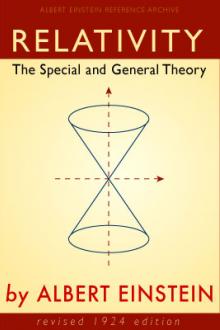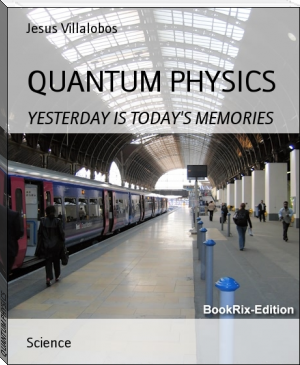The Uncertainty Principle: by Harish Damodaran (parable of the sower read online txt) 📕

Read free book «The Uncertainty Principle: by Harish Damodaran (parable of the sower read online txt) 📕» - read online or download for free at americanlibrarybooks.com
- Author: Harish Damodaran
Read book online «The Uncertainty Principle: by Harish Damodaran (parable of the sower read online txt) 📕». Author - Harish Damodaran
The Uncertainty Principle:
A Philosophical Perspective
Werner Karl Heisenberg was a celebrated German physicist and Nobel laureate, one of the founders of quantum mechanics, and acknowledged to be one of the most important physicists of the twentieth century.
He is most well-known for discovering one of the central principles of modern physics, the epoch-making uncertainty principle that shook the very foundations of the ‘deterministic sciences’.
Determinism: The Theory of Measures
Classical Physics is based on the theory of determinism, put forward by La Place. It holds that there is Cause-Effect relation the world over. To know the state of affairs of a thing or an event at a particular point of time is to know its past and to predict its future.
Until the dawn of the 20th century, the physicists were following the Laplacean determinism that believed in the ‘exact’ ‘certain’ nature of things or happenings. To them, the Universe looked like a perfect clock. Once we know the position of its parts at one instant, they would forever be specified.
This deterministic view is expressed by Laplace in an oft-quoted passage:
We ought then to regard the present state of the universe as the effect of its antecedent state and the cause of the state that is to follow. An intelligence knowing at any given instant of time all forces acting in nature, as well as the momentary positions of all things of which the universe consists, would be able to comprehend the motions of the largest bodies of the world and those of the smallest atoms in one single formula, provided it were sufficiently powerful to subject all data to analysis: to it nothing would be uncertain, both future and past would be present before its eyes.
Measure for Measure
In 1920s, the German Scientist, Werner Karl Heisenberg, a student of Niels Bohr, entered the scene with his epoch-making Uncertainty Principle that challenged the Theory of Determinism.
Heisenberg showed that the subatomic entities like the electron can never be measured or determined in a ‘casual way’. There is and must always be an element of uncertainty or indeterminacy in our knowledge. This discovery is known as the uncertainty principle.
The uncertainty relations may be expressed in words as follows.
The simultaneous measurement of two conjugate variables (such as the momentum and position or the energy and time for a moving particle) entails a limitation on the precision (standard deviation) of each measurement. Namely: the more precise the measurement of position, the more imprecise the measurement of momentum, and vice versa. In the most extreme case, absolute precision of one variable would entail absolute imprecision regarding the other.
The uncertainty relations can be written a little more precisely in the shorthand of mathematical symbols. But first we must define what these symbols stand for. Here are their definitions:
Δq is the uncertainty or imprecision (standard deviation) of the position measurement.
Δp is the uncertainty of the momentum measurement in the q direction at the same time as the q measurement.
ΔE is the uncertainty in the energy measurement.
Δt is the uncertainty in the time measurement at the same time as the energy is measured.
h is a constant from quantum theory known as Planck's constant, a very tiny number.
π is pi from the geometry of circles.
≥ means "greater than or equal to"
Putting these symbols together, the two uncertainty relations look like this:
Δp . Δq ≥ h / 4 π
ΔE . Δt ≥ h / 4 π
Let's see when we measure the position of a moving electron with such great accuracy that, Δq is very small, what happens to the precision of the momentum, Δp which we measure at the same instant.
From the first relation, we have,
Δp ≥ h / 4 πΔq
We can see that the uncertainty in the momentum measurement, Δp is very large, since Δq in the denominator is very small. In fact, if the precision of the position measurement gets so great that the uncertainty Δq gets so small that it approaches zero, then Δp gets so large that it approaches infinity or becomes completely undefined.
Following Heisenberg's derivation of the uncertainty relations, one starts with an electron moving all by itself through empty space. To describe the electron, a physicist would refer to certain measured properties of the particle. Four of these measured properties are important for the uncertainty principle. They are the position of the electron, its momentum (which is the electron's mass times its velocity), its energy, and the time. These properties appear as "variables" in equations that describe the electron's motion.
The uncertainty relations have to do with the measurement of these four properties; in particular, they have to do with the precision with which these properties can be measured. Up until the advent of quantum mechanics, everyone thought that the precision of any measurement was limited only by the accuracy of the instruments the experimenter used. Heisenberg showed that no matter how accurate the instruments used, quantum mechanics limits the precision when two properties are measured at the same time. These are not just any two properties but two that are represented by variables that have a special relationship in the equations. The technical term is "canonically conjugate" variables. For the moving electron, the canonically conjugate variables are in two pairs: momentum and position is one pair, and energy and time another. Roughly speaking, the relation between momentum and position is like the relation between energy and time.
Heisenberg pictured a microscope that obtains very high resolution by using high-energy gamma rays for illumination. No such microscope exists at present, but it could be constructed in principle. Heisenberg imagined using this microscope to see an electron and to measure its position.
Here, a free electron sits directly beneath the center of the microscope's lens. The circular lens forms a cone of angle 2A from the electron. The electron is then illuminated by gamma rays--high energy light which has the shortest wavelength. These yield the highest resolution, for according to a principle of wave optics, the microscope can resolve (that is, "see" or distinguish) objects to a size of x, which is related to and to the wavelength L of the gamma ray, by the expression:
x = L / (2sinA)
However, in quantum mechanics, where a light wave can act like a particle, a gamma ray striking an electron gives it a kick. At the moment the light is diffracted by the electron into the microscope lens, the electron is thrust to the right. To be observed by the microscope, the gamma ray must be scattered into any angle within the cone of angle 2A. In quantum mechanics, the gamma ray carries momentum, as if it were a particle. The total momentum p is related to the wavelength by the formula
p = h / L, where h is Planck's constant.
In the extreme case of diffraction of the gamma ray, say, to the right edge of the lens, the total momentum in the x direction would be the sum of the electron's momentum p'x in the x direction and the gamma ray's momentum in the x direction:
p'x + (h sinA ) / L',
Where L' is the wavelength of the deflected gamma ray.
In the other extreme, the observed gamma ray recoils backward, just hitting the left edge of the lens. In this case, the total momentum in the x direction is:
p''x - (h sinA ) / L''
The final x momentum in each case must equal the initial x momentum, since momentum is never lost (it is conserved). Therefore, the final x momenta are equal to each other:
p'x + (h sinA ) / L' = p''x - (h sinA ) / L''
If A is small, then the wavelengths are approximately the same,
L' ~ L" ~ L.
So we have
p''x - p'x = px ~ 2h sinA / L
Since x = L / (2 sinA ) ,
we obtain a reciprocal relationship between the minimum uncertainty in the measured position, x, of the electron along the X axis and the uncertainty in its momentum, px, in the X direction:
px ~ h / x
or px x ~ h.
For more than minimum uncertainty, the "greater than" sign may be added.
Except for the factor of 4 π and an equal sign, this is Heisenberg's uncertainty relation for the simultaneous measurement of the position and momentum of an object.
Uncertainty relations have profound scientific and philosophical implications. First, if we accept Heisenberg's argument that every concept has a meaning only in terms of the experiments used to measure it, we must agree that things that cannot be measured really have no meaning in physics. Thus, for instance, the path of a particle has no meaning beyond the precision with which it is observed. But a basic assumption of physics since Newton has been that a "real world" exists independently of us, regardless of whether or not we observe it.
Heisenberg argued that such concepts as orbits of electrons do not exist in nature unless and until we observe them.
Heisenberg’s principle demolishes two old pillars of classical physics: causality and the objective description of reality.
First, if we accept Heisenberg's argument that every concept has a meaning only in terms of the experiments used to measure it, we must agree that things that cannot be measured really have no meaning in physics. Thus, for instance, the path of a particle has no meaning beyond the precision with which it is observed. But a basic assumption of physics since Newton has been that a "real world" exists independently of us, regardless of whether or not we observe it.
“The existence of the classical path can be formulated as follows: The "path" comes into existence only when we observe it.”
--Heisenberg, in uncertainty principle paper, 1927
If one wants to be clear about what is meant by "position of an object," for example of an electron..., then one has to specify definite experiments by which the "position of an electron" can be measured; otherwise this term has no meaning at all.
--Heisenberg, in uncertainty paper, 1927
The detached ‘observer-scientist’ of the classical physics is no more a detached observer, looking through a microscope at something separate from himself. But, he is the participator, if not the main actor, in the process. Reality in the quantum world is no more purely objective, but is connected with the subjective element of the physicist. His consciousness acts as the hidden variable of the observed event.
Consequently, Physicists had to admit that atoms are not real things- they had to move far and far away from Newtonian Science. They agreed, “we must get away from the idea of objective process in time and space”.
Thought Experiment
Heisenberg suggested a thought experiment to verify his principle. It runs as: a gamma ray microscope is used to detect the position of an electron. But once the ray hits the electron, it absorbs energy from the ray and escapes. The scientist observes it at a position where it is not





Comments (0)